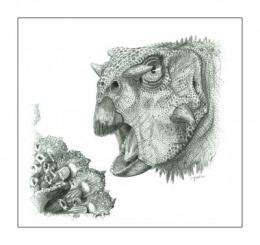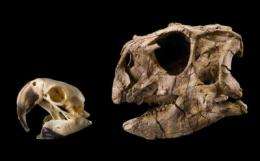Sands of Gobi Desert yield new species of nut-cracking dinosaur

Plants or meat: That's about all that fossils ever tell paleontologists about a dinosaur's diet. But the skull characteristics of a new species of parrot-beaked dinosaur and its associated gizzard stones indicate that the animal fed on nuts and/or seeds. These characteristics present the first solid evidence of nut-eating in any dinosaur.
"The parallels in the skull to that in parrots, the descendants of dinosaurs most famous for their nut-cracking habits, is remarkable," said Paul Sereno, a paleontologist at the University of Chicago and National Geographic Explorer-in-Residence. Sereno and two colleagues from the People's Republic of China announce their discovery June 17 in the Proceedings of the Royal Society B.

The paleontologists discovered the new dinosaur, which they've named Psittacosaurus gobiensis, in the Gobi Desert of Inner Mongolia in 2001, and spent years preparing and studying the specimen. The dinosaur is approximately 110 million years old, dating to the mid-Cretaceous Period.
The quantity and size of gizzard stones in birds correlates with dietary preference. Larger, more numerous gizzard stones point to a diet of harder food, such as nuts and seeds. "The psittacosaur at hand has a huge pile of stomach stones, more than 50, to grind away at whatever it eats, and this is totally out of proportion to its three-foot body length," Sereno explained.
Technically speaking, the dinosaur is also important because it displays a whole new way of chewing, which Sereno and co-authors have dubbed "inclined-angle" chewing. "The jaws are drawn backward and upward instead of just closing or moving fore and aft," Sereno said. "It remains to be seen whether some other plant-eating dinosaurs or other reptiles had the same mechanism."
The unusual chewing style has solved a major mystery regarding the wear patterns on psittacosaur teeth. Psittacosaurs sported rigid skulls, but their teeth show the same sliding wear patterns as plant-eating dinosaurs with flexible skulls.
Source: University of Chicago (news : web)




















